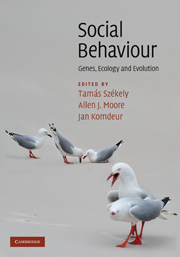Book contents
- Frontmatter
- Contents
- List of contributors
- Introduction: The uphill climb of sociobiology: towards a new synthesis
- Profile: Undiminished passion
- Part I Foundations
- Part II Themes
- 7 Aggression: towards an integration of gene, brain and behaviour
- Profile: From behavioural observations, to genes, to evolution
- 8 Social influences on communication signals: from honesty to exploitation
- Profile: Reputation can make the world go round – or why we are sometimes social
- 9 Important topics in group living
- Profile: A haphazard career
- 10 Sexual behaviour: conflict, cooperation and coevolution
- Profile: In celebration of questions, past, present and future
- 11 Pair bonds and parental behaviour
- Profile: Mating systems and genetic variation
- 12 Adaptations and constraints in the evolution of delayed dispersal: implications for cooperation
- Profile: Selections from a life in social selection
- 13 Social behaviour in microorganisms
- Profile: The de novo evolution of cooperation: an unlikely event
- 14 Social environments, social tactics and their fitness consequences in complex mammalian societies
- Profile: Evolutionary genetics and social behaviour: changed perspectives on sexual coevolution
- 15 Social behaviour in humans
- Profile: Genes and social behaviour: from gene to genome to 1000 genomes
- Part III Implications
- Species index
- Subject index
- References
13 - Social behaviour in microorganisms
Published online by Cambridge University Press: 05 June 2012
- Frontmatter
- Contents
- List of contributors
- Introduction: The uphill climb of sociobiology: towards a new synthesis
- Profile: Undiminished passion
- Part I Foundations
- Part II Themes
- 7 Aggression: towards an integration of gene, brain and behaviour
- Profile: From behavioural observations, to genes, to evolution
- 8 Social influences on communication signals: from honesty to exploitation
- Profile: Reputation can make the world go round – or why we are sometimes social
- 9 Important topics in group living
- Profile: A haphazard career
- 10 Sexual behaviour: conflict, cooperation and coevolution
- Profile: In celebration of questions, past, present and future
- 11 Pair bonds and parental behaviour
- Profile: Mating systems and genetic variation
- 12 Adaptations and constraints in the evolution of delayed dispersal: implications for cooperation
- Profile: Selections from a life in social selection
- 13 Social behaviour in microorganisms
- Profile: The de novo evolution of cooperation: an unlikely event
- 14 Social environments, social tactics and their fitness consequences in complex mammalian societies
- Profile: Evolutionary genetics and social behaviour: changed perspectives on sexual coevolution
- 15 Social behaviour in humans
- Profile: Genes and social behaviour: from gene to genome to 1000 genomes
- Part III Implications
- Species index
- Subject index
- References
Summary
OVERVIEW
Sociobiology has come a long way. We now have a solid base of evolutionary theory supported by a myriad of empirical tests. It is perhaps less appreciated, however, that first discussions of social behaviour and evolution in Darwin's day drew upon single-celled organisms. Since then, microbes have received short shrift, and their full spectrum of sociality has only recently come to light. Almost everything that a microorganism does has social consequences; simply dividing can consume another's resources. Microbes also secrete a wide range of products that affect others, including digestive enzymes, toxins, molecules for communication and DNA that allows genes to mix both within and among species. Many species do all of this in surface-attached communities, known as biofilms, in which the diversity of species and interactions reaches bewildering heights. Grouping can even involve differentiation and development, as in the spectacular multicellular escape responses of slime moulds and myxobacteria. Like any society, however, microbes face conflict, and most groups will involve instances of both cooperation and competition among their members. And, as in any society, microbial conflicts are mediated by three key processes: constraints on rebellion, coercion that enforces compliance, and kinship whereby cells direct altruistic aid towards clone-mates.
- Type
- Chapter
- Information
- Social BehaviourGenes, Ecology and Evolution, pp. 331 - 356Publisher: Cambridge University PressPrint publication year: 2010
References
- 16
- Cited by

